Recent U.S. efforts to restart the peace process between Israel and the Palestinians, and the repositioning of the Arab Peace Initiative to support these efforts, may signify a new political opportunity. This is a critical time for the Palestinian Authority (PA). The deep financial crisis it is experiencing, due on the one hand to a sharp decline in external aid and its restrictive economic agreement with Israel, and on the other, to the continued internal conflict within Palestinian society and among its leadership, undermine the PA’s stability and endanger its ability to continue functioning as a governing body.
The Palestinian Authority’s long-term development plans, which were spear-headed for the past six years by Dr. Salam Fayyad (2008-2013), permitted social and institutional recovery. The PA implemented its plans with generous financial aid from the international community, and with Israel’s support and encouragement, for example by removing roadblocks and allowing easier access and movement. Its stated goal was to build the state from the “bottom up”: to reorganize government institutions and strengthen the PA’s social and security foundations, while developing a sustainable economic system, in order to turn the PA into a de-facto state. The assumption was that the PA and the Palestinian people would thus prove to Israel and the international community that they are able to take responsibility for the land and population. This would negate the Israeli claims that the Palestinians are not ready to establish a state, could not be partners in a peace agreement, and would not keep agreements and commitments in the future.
At the same time, PA President Mahmoud Abbas attempted, with the encouragement of the international community, to promote the establishment of the Palestinian state. These parallel efforts—political negotiations and state-building—seemed promising to the international community, which considered these processes to fulfill the terms of the “Road Map,”[1] leading to a two-state solution. A large amount of aid was transferred to the PA, which began to make achievements in maintaining security, enforcing the law, improving the legal system, managing a transparent and efficient budget, as well as improving public services, especially health and education.[2] However, while the PA progressed in these fields and achieved security to Israel's satisfaction and that of the international community, the political process came to a standstill due to a dispute over the terms of resumption of negotiations. In Palestinian and international public opinion, Israel was held primarily responsible for the stagnation, due to its failure to fulfill its Road Map obligations, for example by allowing construction in the settlements.
As a result of the political stagnation, the state-building process was severely disrupted, and the PA experienced a grave economic crisis. Building a state from the “bottom up,” independently of the political process, only worked to a point. Since 2011, external aid diminished considerably, mainly as a result of the political impasse, and the PA has encountered barriers and limitations related to economic agreements between the Palestinians and Israel, dictated by the political status quo. This has prevented economic development and infrastructure building. Thus, in the absence of substantial progress towards a permanent political settlement which would remove economic limitations (for example, by expanding the PA’s very limited control and planning authority in Area C, which is 60 percent of the West Bank),[3] government institutions were left hanging by a thread. In the past two years, the PA has had great difficulty funding its budget, maintaining public services and paying the salaries of employees in the public sector, including security personnel.
The immediate cause of the PA’s severe economic crisis is the steep decline in external financial aid to the PA, but the crisis’s underlying causes are the fundamental weaknesses of the Palestinian economy. These weaknesses developed during direct Israeli rule, between 1967 and 1993, and deepened in the last twenty years under the PA. They include an underdeveloped economic infrastructure, reflecting two generations of very low investment in infrastructure; a complex system of obstacles arising from the restrictive economic and trade agreements with Israel, as well as restrictions on movement and access and other physical and administrative limitations on economic activity. All this sits alongside demographic and social pressures and severe structural unemployment, especially among educated youth.[4] This gloomy situation is reflected in all macro-economic parameters, first and foremost in a distorted structure of the economy and an economic growth extremely inclined towards consumption funded by external resources.
Chart 1 shows that the rapid economic growth from 2005-2010 expressed, in fact, massive real growth in private consumption, which increased by 70 percent between 2002 (the low point of the Second Intifada) and 2011. Public consumption—current government expenses and direct aid from international aid agencies to the public in the West Bank and the Gaza Strip—doubled, and there was significant growth in residential housing construction. However, investment in the production capacity of the Palestinian economy—infrastructure, industry, agriculture and long-term growth-promoting services, such as tourism and information technology—were low and declined steeply in recent years.
From 2008-2012, annual investment in productive assets shrunk to half to two-thirds of the level of investment on the eve of the Second Intifada (in constant prices); and its percentage of the Palestinian GDP declined dramatically: from 10-15 percent of the GDP before the Intifada, to 3-5 percent of the GDP in recent years.
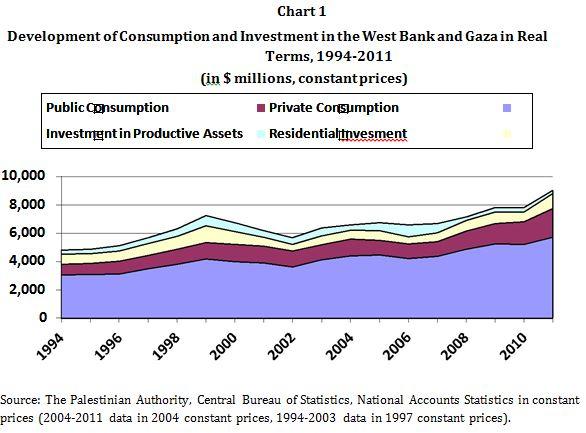
Chart 2 illustrates the dramatic change for the worse that took place in the Palestinian economic structure as a result of these trends. Agriculture and industry, the main productive sectors, have not grown in real terms since the Palestinian Authority was established in 1994. As a result, the share of the agricultural sector, which was about 12 percent of the GDP in 1994, declined to 5-6 percent in recent years; while the share of industry, which amounted to about 20 percent of output in 1994, declined by half, to about 10 percent.
Some important service sectors, such as tourism, communications and information technology, have grown considerably, but their weight of the GDP remained insignificant. Economic growth was concentrated, almost in its entirety, in commerce, services and residential construction, providing a mirror image to the vast growth in private and public consumption, funded by external aid.
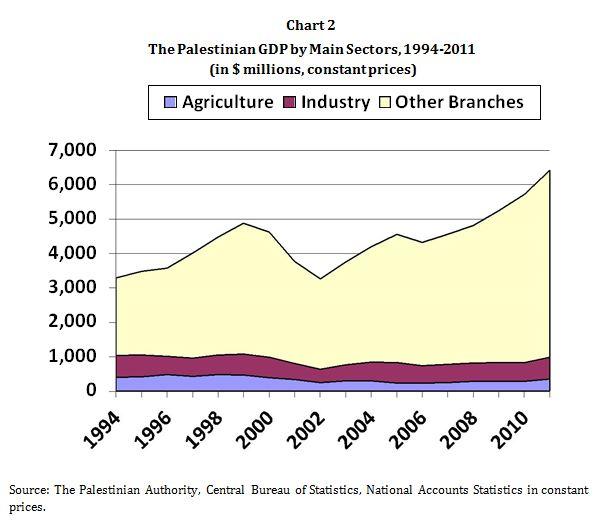
The lack of growth in the main manufacturing sectors (industry and agriculture), and the weakness of employment-promoting service sectors such as tourism, greatly constrain the Palestinian economy’s ability to create jobs in the business sector. Furthermore, the public sector exhausted its ability to take in new employees in the middle of the past decade. These weaknesses are reflected in the high unemployment rates that characterize the Palestinian economy. Unemployment is especially severe among young university and college graduates, who join the workforce in large numbers every year. The rate of unemployment among them exceeds 50 percent, in comparison to unemployment of about 25–30 percent for the total workforce (see Chart 4).

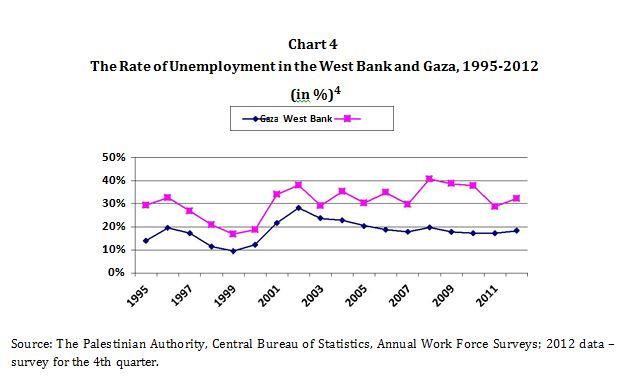
Two other major aspects of Israel’s great influence on the Palestinian economy are worth noting. One is the frenetic pattern of economic growth: great leaps in years of relative political and security calm, and steep declines in years of violent outbreaks, as can be seen in Chart 5.
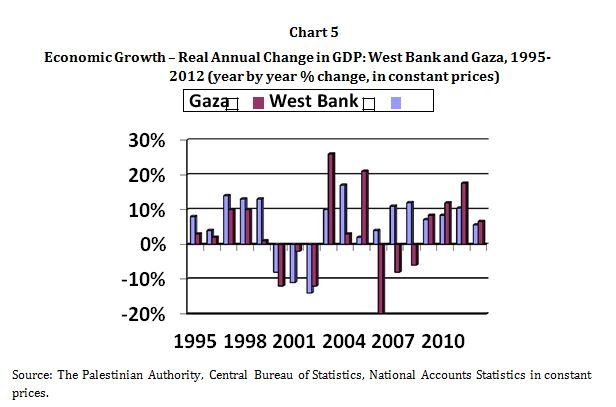
Another aspect is Israel’s impact on Palestinian purchasing power and standard of living. Economic integration with Israel has created a price level in the Palestinian territories close to that in Israel, although the average Palestinian salary is considerably lower than the average Israeli salary: The average wage in the West Bank is less than a quarter of the Israeli average, and the average in Gaza is even lower. As a result, the real purchasing power of Palestinian households is relatively low. International comparisons show that Palestinian GDP per capita, when adjusted to the local purchasing power, is much lower than that of neighboring Arab countries, and is only a little higher than that of very poor countries such as Sudan or Yemen, as can be seen in Chart 6.
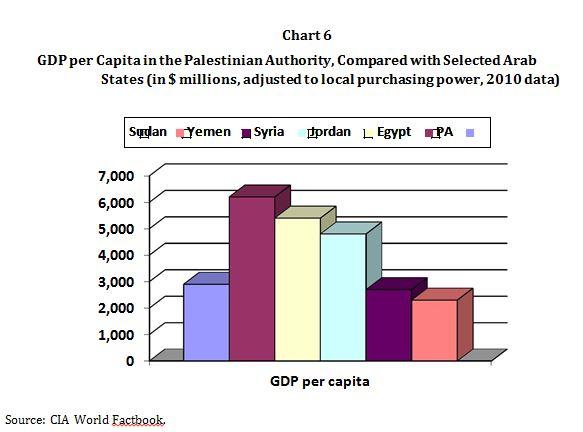
The complex web of economic, physical and administrative constraints the Palestinian Authority is subject to, and the broad Israeli control over almost every aspect of the PA’s economic activity and policy-making, prevent it from effectively tackling these weaknesses.
The PA’s foreign trade deficit made the Palestinian economy critically dependent on large and continuous foreign aid to maintain its economic life. In the past two years, the steep decline in foreign aid has brought the PA close to insolvency. The PA was unable to pay the salaries of public sector employees fully and on time. Payments were irregular and depended on delayed “emergency aid” from donors or on the transfer of taxes collected by Israel for the PA.
The Palestinian Authority has been forced to borrow continuously from the local banking system in order to fund current deficits. At the end of 2012, local public debt was more than double the 2008 level. In addition, there was an external public debt of over a billion dollars. At such a level of debt, the PA is unable to take more loans; therefore, in 2012 it became completely dependent on foreign aid and money transfers from Israel to pay salaries and fund its activities.
The economic and social impacts of this situation are far-reaching. Employees of the state and the security apparatus account for more than a quarter of purchasing power, and their salaries are the pillars of economic and social stability in the West Bank. When these salaries are not paid fully and on time, the financial stability of public sector employees is damaged and repercussions spread throughout the West Bank.
This political stagnation is weakening the Palestinian Authority’s status from within. Its leadership has been unable to translate the UN’s November 2012 acknowledgement of “Palestine” as a non-member observer state into an achievement which will allow it to expand its control over the West Bank and improve its standing in the eyes of the public. While the PA welcomes achievements such as Google giving “Palestine” a domain name, upgrading diplomatic relations with other countries and joining international organizations, the Palestinian public is indifferent to anything that does not affect its economy or change the reality of the occupation. The PA and its security apparatus increasingly seem like Israel’s proxies and servants of its policy, with no end in sight to the occupation. Palestinian public opinion is that its leadership has failed and its ability to govern has weakened.
Because donor countries are uninterested in continuing their economic support without a political horizon, there is an urgent need to restart the political process and progress towards an agreement. The failure of current American attempts to restart negotiations might lead the Quartet countries and the donors to disengage themselves from active involvement in the Israeli-Palestinian conflict, and to further reduce aid to the PA. This may lead to the PA’s rapid disintegration due to failure to meet its financial obligations, which will be accelerated by the pressure of the economic crisis and the internal-political rift. Under these conditions, and in the absence of general elections, the PA’s legitimacy in public opinion will continue to erode.
These developments might mark the end of Israel’s and the PA’s strategy to reach calm and to maintain proper cooperation in civil fields, while focusing on building “the state to be.” This strategy has not met its goals; instead of progressing towards developing a sustainable economy, it has brought about a complete dependence on external aid. Accordingly, belief in the PA’s ability to maintain a stable government and regional security is being increasingly eroded.
Although the majority of the Palestinian public and leadership is still interested in maintaining calm, popular unrest might develop if the stagnation continues. Under these circumstances, the positions of Hamas and other opposition groups might be strengthened, undermining the stability achieved through Israeli military presence in the area and security coordination. Such a development would further reduce the likelihood that the PA will be able to function as an effective government and independently enforce its authority over the territory and population. Amendment of the economic arrangements, continued building of the Palestinian state and the PA’s gradual release from complete dependence on foreign aid and on Israel all depend today on real progress towards a political agreement.
[1] A plan proposed in 2002 by the Quartet on the Middle East to resolve the Israeli–Palestinian conflict.
[2] See: Ephraim Lavie, “Building the State from Below: An Assessment of Achievements and Challenges in the Development Plans,” in Ephraim Lavie and Yitzhak Gal (eds.), “Palestine” – A State in the Making? (Tel Aviv University: The Tami Steinmetz Center and Moshe Dayan Center, 2012), pp. 17-46.
[3] For a detailed description and analysis of the many limitations and barriers on the economic activity and the possibilities of economic development in the PA, see: ibid., Yitzhak Gal, “The Economic Viability of a Palestinian State: Insights and Analysis in a Long-Term Perspective,” pp. 84-88; Rassem Khamaisi, “Preparation of Spatial Planning for the Palestinian State: Obstacles, Dilemmas and Challenges,” pp. 47-53, 63-72.
[4] According to the International Labour Organization’s restrictive definition, a person is considered unemployed only if he hasn’t worked at all during the period measured and has been actively looking for a job. According to the expansive definition, including those who despaired of actively looking for a job, the rates are higher by 6-10 percentage points. In the last quarter of 2012, the average rate of unemployment in the West Bank and Gaza was 24 percent (restrictive definition) or over 30 percent (expansive definition).








